Who Controls the User Experience? AMD’s Carrizo Thoroughly Tested
by Ian Cutress on February 4, 2016 8:00 AM ESTBenchmark Results: CPU Short Form
Here are our results from our CPU tests. A reminder of our systems:
| System Overview | |||||
| µArch | APU | Base / Turbo MHz | Memory | Channel | |
| HP Elitebook 745 G2 | Kaveri | A10 PRO-7350B (19W) | 2100 / 3300 | 8 GB | Dual |
| HP Elitebook 745 G3 | Carrizo | PRO A12-8800B (15W) | 2100 / 3400 | 4 GB | Single |
| Toshiba Satellite E45DW-C4210 |
Carrizo | FX-8800P (15W) | 2100 / 3400 | 8 GB | Single |
| HP Pavilion 17z-g100 |
Carrizo | A10-8700P (15W) | 1800 / 3200 | 8 GB | Single |
| Lenovo Y700 | Carrizo | FX-8800P (35W) | 2100 / 3400 | 16 GB | Single |
Three Dimensional Particle Movement (3DPM)
3DPM is a self-penned benchmark, derived from my academic research years looking at particle movement parallelism. The coding for this tool was rough, but emulates the real world in being non-CompSci trained code for a scientific endeavor. The code is unoptimized, but the test uses OpenMP to move particles around a field using one of six 3D movement algorithms in turn, each of which is found in the academic literature. This test is performed in single thread and multithreaded workloads, and uses purely floating point numbers. The code was written in Visual Studio 2008 in Release mode with all optimizations (including fast math and –Ox) enabled. We take the average of six runs in each instance.
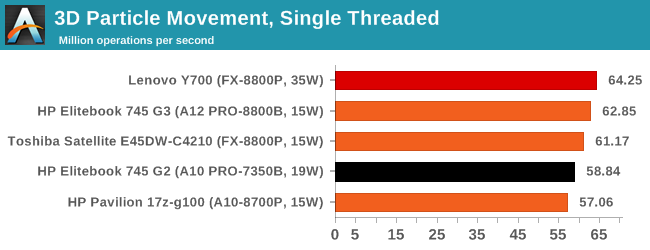
In the single threaded mode, the 35W part is able to boost to a higher frequency, giving it the lead. The interesting element here is the mix of 15W and 19W results, putting the Pavilion with the A10-8700P at the bottom. This comes through in the frequency charts, where the Kaveri was able to boost above 3000 MHz often:
For multithreaded:

The processors line up more as expected, with the 8800P still taking the top spot with Carrizo’s architecture resources showing the ability to scale better.
WinRAR 5.01
WinRAR is a compression tool to reduce file size at the expense of CPU cycles. We use the version that has been a stable part of our benchmark database through 2015, and run the default settings on a 1.52GB directory containing over 2800 files representing a small website with around thirty half-minute videos. We take the average of several runs in this instance.
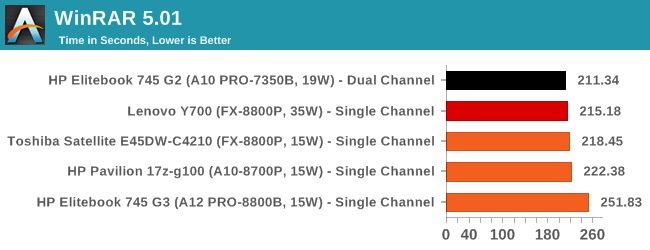
WinRAR is a benchmark which loves DRAM speed, hence why the dual channel Kaveri system wins despite the increased horse power and thermal benefits of the Lenovo Y700. Unfortunately, the single channel design methodology permeates through the OEMs because of the factor of price and upgradability – if a machine is sold with only one module, it can be upgraded later. The other element is that the Y700 design also caters for Carrizo-L as pin compatible, so despite having two modules in there the system will always be limited to single channel. This is, perhaps, a grave error with any situation that is memory limited.
POV-Ray 3.7 beta
POV-Ray is a common ray-tracing tool used to generate realistic looking scenes. We've used POV-Ray in its various guises over the years as a good benchmark for performance, as well as a tool on the march to ray-tracing limited immersive environments. We use the built-in multithreaded benchmark.
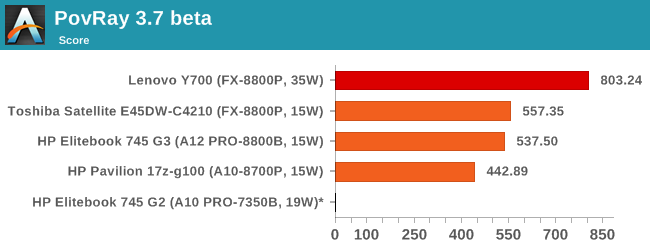
For whatever reason, our script failed to record the score when it came to the Kaveri system and we only realized after the systems were returned. Nonetheless, the capabilities of the other systems shine through, showing that the A10-8700P can seem to have a big frequency discrepancy against the FX-8800P models. In actual fact this can be attributed to the temperature limitations on the Pavilion:
The full threaded nature of POV-Ray means that we’re on the limits of the A10 APU already, but when the system hits 55C or so, it clocks back to 2100 MHz to save a few extra degrees.
If we compare that to the Toshiba:
The Toshiba system also hits a temperature limit, but the barrier is way up at 70C, causing the system to knock back to 64C. The CPU frequency difference between the two does not look that different despite the +25% score in favor of the Toshiba, making it slightly deceptive.
HandBrake
HandBrake is a freeware video conversion tool. We use the tool in to process two different videos - first a 'low quality' two hour video at 640x388 resolution to x264, then a 'high quality' ten minute video at 4320x3840. The low quality video scales at lower performance hardware, whereas the buffers required for high-quality can stretch even the biggest processors. At current, this is a CPU only test.
Unfortunately HandBrake also had issues on a couple of systems – the Lenovo and the Toshiba. All the HP systems gave results, where the HP Pavilion came out on top:


If we compare CPU use, the HP Pavilion is much better at using all of its threads than the Elitebook 745 G3:
7-Zip
7-Zip is a freeware compression/decompression tool that is widely deployed across the world. We run the included benchmark tool using a 50MB library and take the average of a set of fixed-time results.
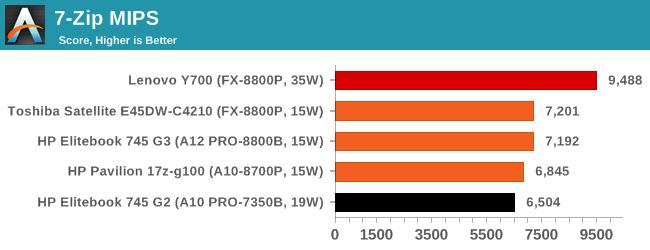
Despite being a purely in-memory benchmark, the G2 shows some inefficiency compared to the Carrizo systems. The slight discrepancy between the 8800 and 8700 shows again, and the Y700 can stretch its legs. Interestingly, the Y700 was able to keep its full CPU frequency on all the time:
Despite the temperature of the CPU moving between 55C and 65C, the system never once reduced its frequency.







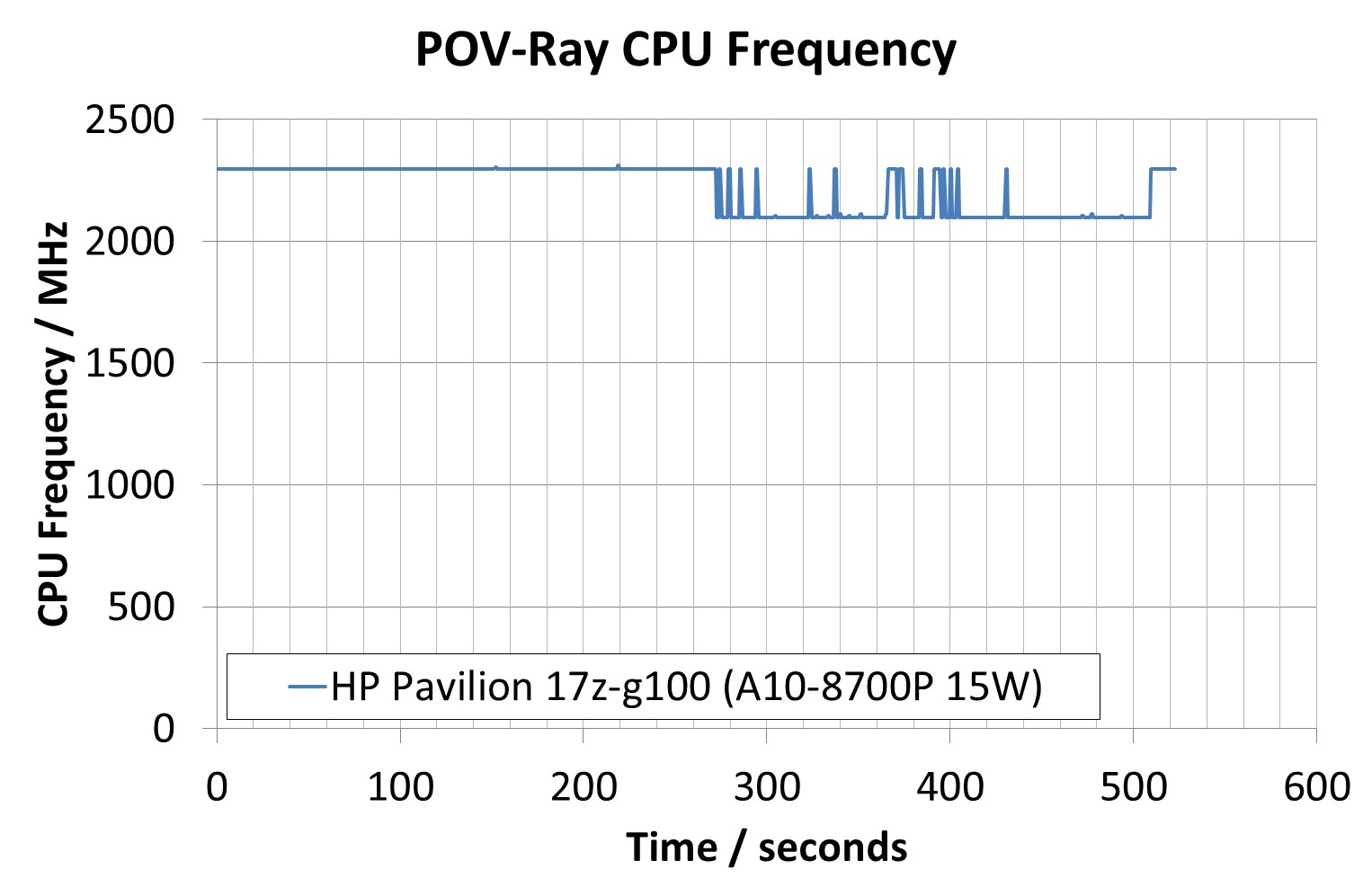
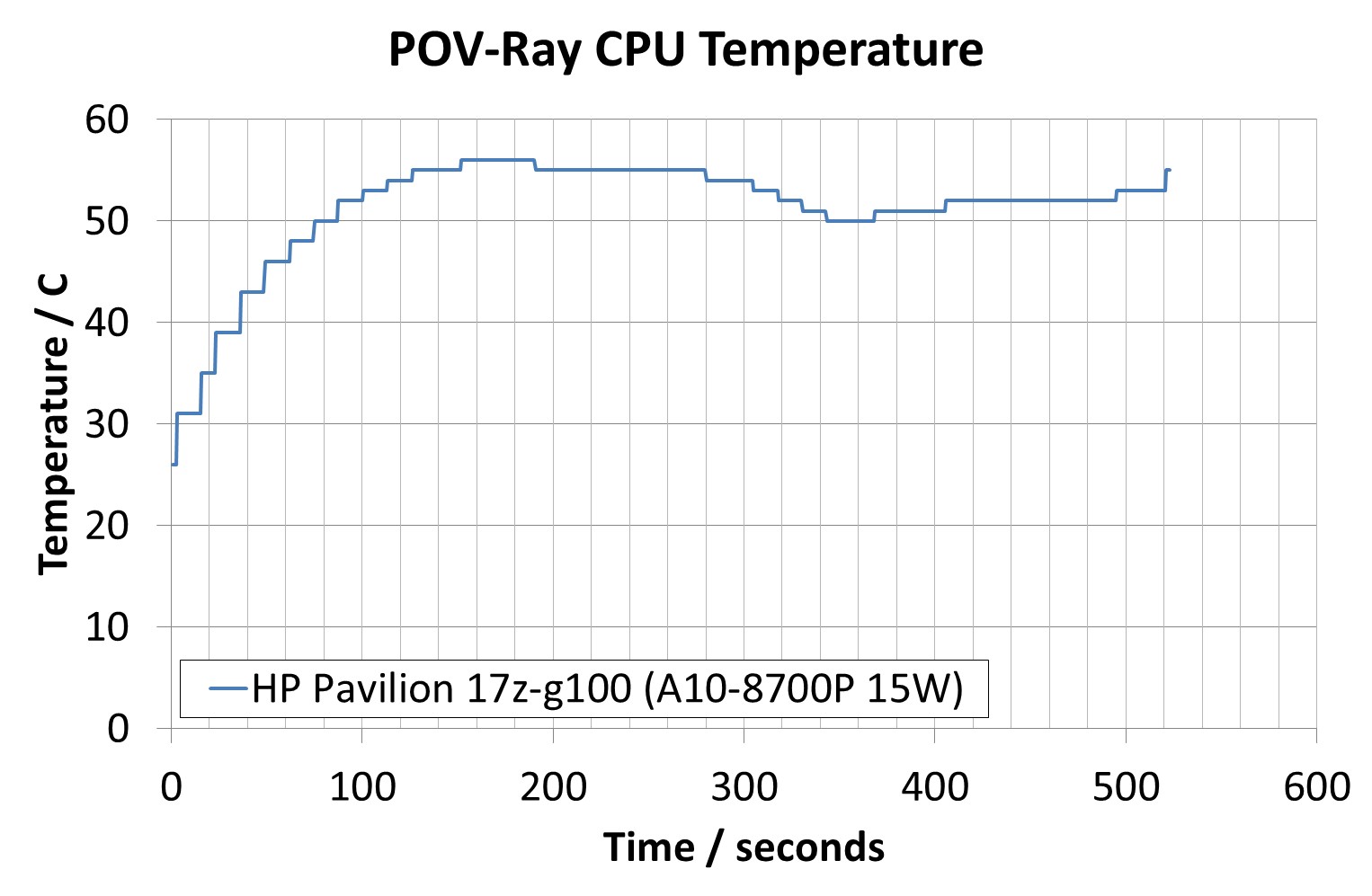


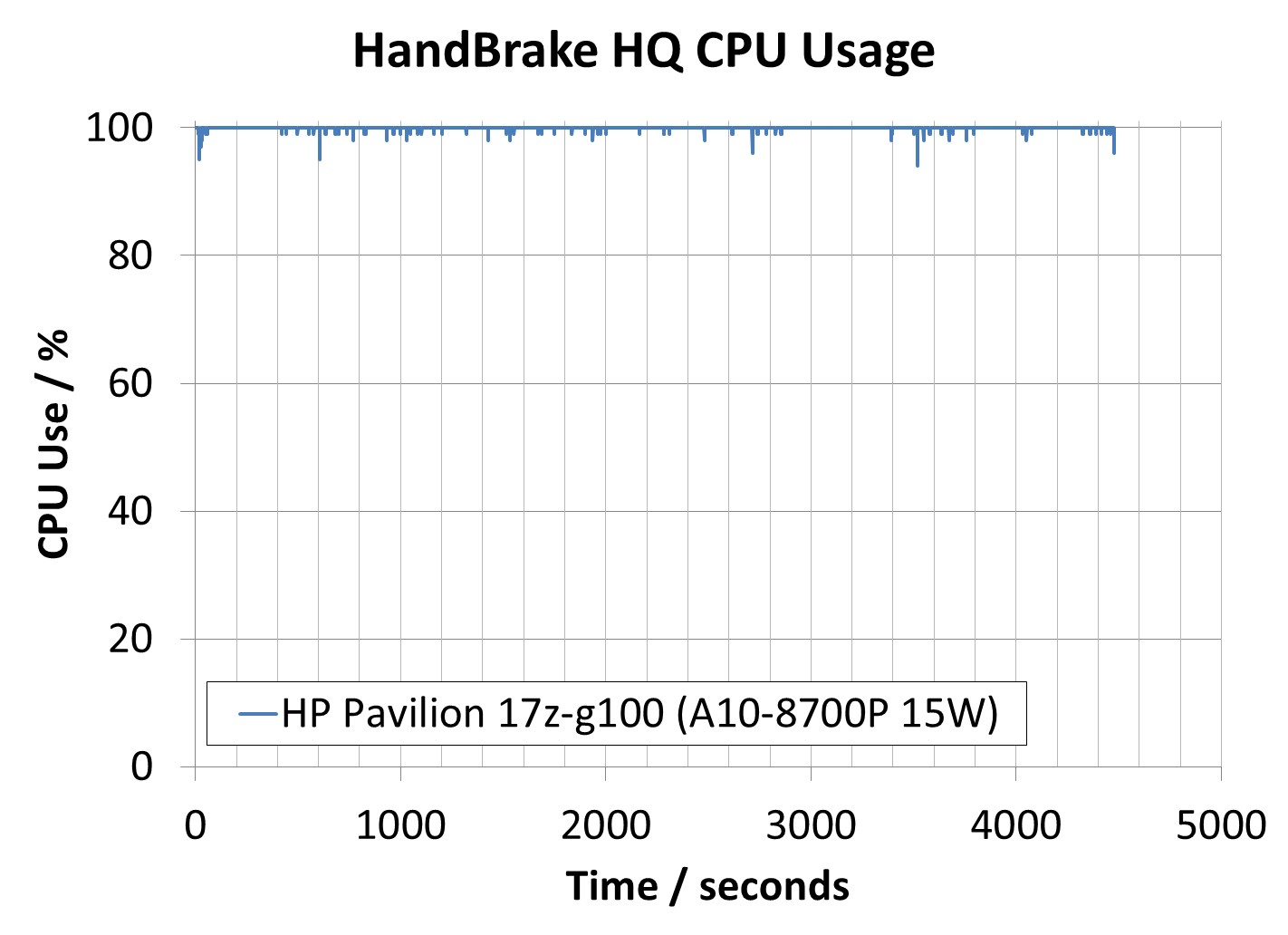

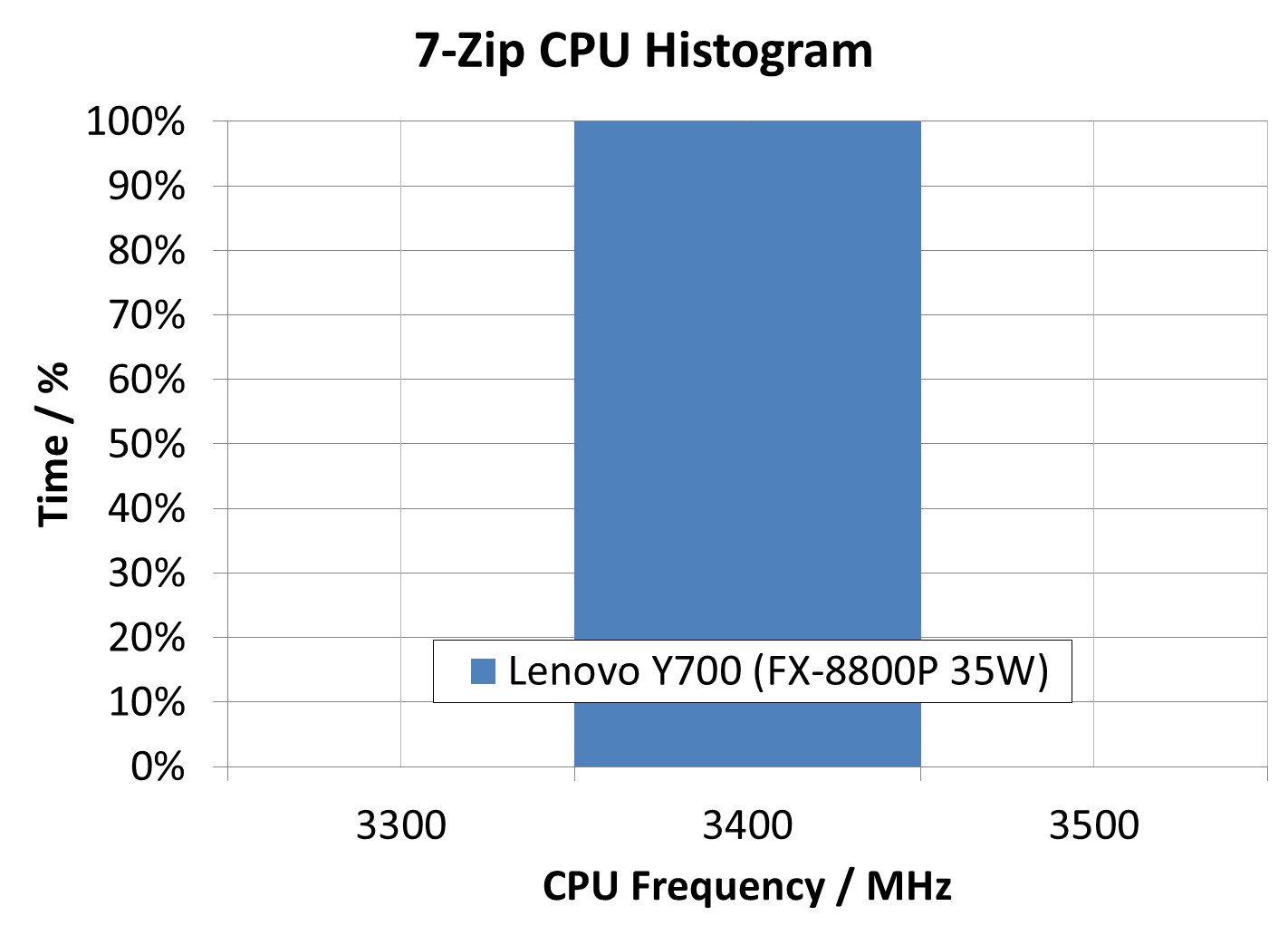









175 Comments
View All Comments
chris471 - Friday, February 5, 2016 - link
What do you do with all those split hares? Are they any good barbecued?("Octane splits hares between the Kaveri ...")
Ian Cutress - Friday, February 5, 2016 - link
Lightly roasted for me :) Edited, thanks!maglito - Friday, February 5, 2016 - link
Were you able to test 18Gbps HDMI? The ability to drive an external display with 2160p 4:2:2 @ 60Hz? I guess the lack of a 10bit accelerated video decoder almost makes the point moot for future 2160p content though....Otherwise, fantastic article!
MonkeyPaw - Friday, February 5, 2016 - link
Last time I shopped for a laptop (which was recently), I was considering an A10-based HP with a 1080p screen. The problem I saw was in reviews the battery life was really poor. It looked like HP put a small battery in it, making the thing only worthy as a DTR. I ended up going with a Lenovo with an i3. I guess part of the problem is that there are so many variants of laptops that finding a review of a specific model is impossible, and all you have to go on are things like Amazon or Best Buy ussr reviews, which can be extremely painful to read.Lolimaster - Friday, February 5, 2016 - link
HP sometimes release near "nice" AMD laptops but always cripples it with laughable battery capacities, same models intel inside dont get the nerfs.euskalzabe - Friday, February 5, 2016 - link
That was a wonderful article that I thoroughly enjoyed reading to start my Friday. Long story short, you perfectly define my laptop buying rationale with "SSD, dual channel memory, 8 hours+ light battery, under 2kg, Full HD IPS panel".That's why I bought an i5 UX305. I wanted an AMD machine because I plain like the company and would like them to succeed to bring more competition to Intel, but I found NOTHING even close to the specs you mentioned. The UX305 fit the description perfectly and cost me $750. It was an immediate purchase for me. If AMD managed the OEM relationship to create such a machine, it would be an insta-buy for me. Also, Zenbooks with Zen APUs oculd be a great marketing strategy :)
Shadowmaster625 - Friday, February 5, 2016 - link
AMD is a company that shoots itself in the foot at every opportunity. I am truly perplexed. Their cat cores shouldnt even exist. But not only do those crippled parts exist, they crippled their premium parts by combining the two platforms! WHY? How could they not see that every notebook would be single channel? They wasted the entirety of their ATI purchase, as you can see with the Rocket League results vs Intel. This is a disgrace.AMD needs to realize that it IS AMD who controls the User experience. Look at the Mackbook Air. Look at the Surface Pro. Look at the Playstation 4 and Xbox One. All of these platforms have a set minimum level of performance. Sure they might be more expensive than a $300 atom clunker, but at least the user will not throw the thing out the window after pulling their hair out.
AMD needs to put a floor under their products. 4 cores. 8GB of unified HBM. 512 cores GPU. This is the SoC that they need. Sure they can fuse off a core or whatever to harvest bad dies, but this is the minimum die they should be making. Ideally within 2 years they will move to a 4 core, 16GB HBM, and they will replace one stack of HBM with 128GB of HBF. They need to control the memory bandwidth of their SoC. Take away the ability of the OEMs to cripple performance. Use HBF to take away the ability for OEMs to cripple storage performance also. Do this, and every AMD system will be fast. And it will get design wins.
t.s - Friday, February 5, 2016 - link
If you read the article: AMD not crippled their premium parts. It was OEM. If only OEM create mobos that have dual channel mems.xthetenth - Friday, February 5, 2016 - link
OEMs shaving pennies is as universal a phenomenon as gravity, and designs should be made as such.t.s - Thursday, February 11, 2016 - link
hence the title, "who controls user experience" :)